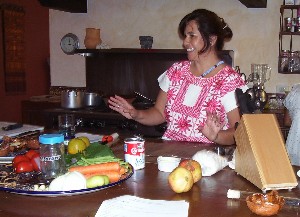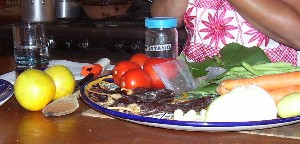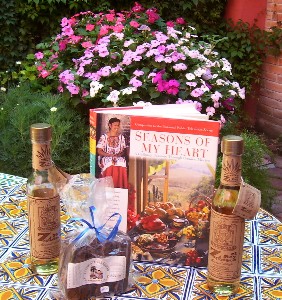Special Feature: Products Sally Recommends
Susana Trilling: Seasons of My Heart Cooking Class
 Susana Trilling, host of the popular PBS cooking show “Seasons of My Heart” and the owner-chef-teacher at the cooking school of the same name, came to San Miguel de Allende from her home base in Oaxaca, Mexico, to teach two cooking classes.
Susana Trilling, host of the popular PBS cooking show “Seasons of My Heart” and the owner-chef-teacher at the cooking school of the same name, came to San Miguel de Allende from her home base in Oaxaca, Mexico, to teach two cooking classes.
I was one of the lucky participants at these cooking classes and plan to take more classes at her ranch in Oaxaca.
Susana studied traditional French cooking techniques and combines the best of those techniques with the complexity of Mexican cuisine. However, it is not only Susana’s great cooking that brings people to her classes; it is also her warmth and generosity. We all received packets of her homemade chocolate, tied with a heart that was made by the Mexican women living near her ranch.
Susana also treated us to some very good mexcal. I always assumed that mexcal was harsh, but the mexcal that Susana brought for us was smooth. We drank the maracuya-flavored mexcal before lunch as an aperitif and ended the meal with the coffee-flavored mexcal. (Maracuya is known as passion fruit.) Susana told us the mexcal, like tequila, is made from the agave plant. Just as champagne can only be called champagne if grown in a certain area, tequila can only be called “tequila” if grown in Jalisco, Mexico. Mexcal is tequila grown elsewhere and in Oaxaca they have elevated mexcal to an art form comparable to cognac or fine wine.
But enough about mexcal—let’s get on with cooking.
 In the first class, we made one of the seven famous moles from Oaxaca, which many consider the epicenter of Mexican cooking. (Susana wrote a great book called “My Search for the Seventh Mole” that describes the seven Oaxacan moles. To purchase this book, contact Susana. Her contact information is at the end of this article.) Unlike Mole Negro, which takes many people and many days to make, Mole Amarillo de Setas y Puerco (Yellow Mole with Oyster Mushrooms and Port) is a quick mole that uses readily available ingredients. The class also made a mango pudding that combined the French charlotte with the Mexican mango. It is quick, easy and delicious (recipe follows).
In the first class, we made one of the seven famous moles from Oaxaca, which many consider the epicenter of Mexican cooking. (Susana wrote a great book called “My Search for the Seventh Mole” that describes the seven Oaxacan moles. To purchase this book, contact Susana. Her contact information is at the end of this article.) Unlike Mole Negro, which takes many people and many days to make, Mole Amarillo de Setas y Puerco (Yellow Mole with Oyster Mushrooms and Port) is a quick mole that uses readily available ingredients. The class also made a mango pudding that combined the French charlotte with the Mexican mango. It is quick, easy and delicious (recipe follows).
I was so excited at the end of the first class that I signed up immediately for the next day’s class. And I was glad that I did.
The main course the second day was Marinated Chicken Wrapped in Banana Leaves (Pilte de Barbacoa de Pollo)—something like tamales without the masa and corn husks. In this dish, chicken pieces are marinated then topped with cooked onions and tomatoes. The chicken and topping are encased in a banana leaf, then placed in a large square of foil. You steam the chicken packets for one hour, remove the foil and serve in the banana leaf. This is elegant enough for a dinner party and adds a festive touch for an informal dinner.
A beautiful rice dish (Arroz Azafran con Pina) accompanied this main course. The saffron rice was molded, with caramelized pineapple mixed in, and placed on fried plantains. This dish was as lovely to look at as it was to eat. I’ve included both of these recipes.

You can contact Susana through her website, which provides class schedules and events, at www.seasonsofmyheart.com
You can also contact Susana by email at seasons@spersaoaxaca.com.mx
Susana’s book, “Seasons of My Heart,” is available online through Amazon.
MARINATED CHICKEN WRAPPED IN BANANA LEAVES
(PILTE DE BARBACOA DE POLLO)
According to Susana, this is a wonderful party dish that is served when all the family is together, such as on Christmas Day or a baptism. The chicken packets can be assembled a day ahead and steamed on the day of serving.
Makes 8 servings
INGREDIENTS
8 fresh banana leaves (12 inches by 8 inches), washed in warm water, or substitute frozen banana leaves, completely defrosted
For the chicken:
5 tablespoons sunflower or vegetable oil
5 chiles guajillos, stemmed, seeded and deveined
3 chiles anchos, stemmed, seeded and deveined
½ medium white onion, thickly sliced
15 garlic cloves
2 bay leaves
1 cup chicken stock
Salt and pepper
1 ½ chickens (about 4 pounds), cut into 8 pieces
For the topping:
2 medium white onions, thinly sliced
1 ¼ pounds tomatoes (2 ½ medium-large round or 10–13 plum), sliced
Salt to taste
To assemble the dish:
8 pieces of aluminum foil, 12 inches by 8 inches
8 avocado leaves, fresh or dried (hoya de aguacate)
METHOD
Cover the banana leaves with water. Boil, for 20 to 30 minutes, covered, or until soft. Older, thicker leaves will take longer. Drain and cool.
For the chicken:
Bring 1 cup of water to boil.
Heat 3 tablespoons of the oil in a medium frying pan. Fry the chiles until they are browned on both sides, then remove from the oil and place in a small bowl. Cover with the boiling water and allow to soak 10 minutes.
In the same oil, fry the onion slices until soft. When they become transparent, add the garlic and fry until clear. Remove from the oil and place onion and garlic in a blender. Add the soaked chiles and just enough of their soaking water to be able to blend mixture well. Reserve the pan and the oil.
In a heavy medium saucepan, heat the remaining 2 tablespoons of oil until smoking hot Pour the chile mixture through a sieve or food mill, add the bay leaves, and fry the sauce 10 minutes. Add the stock and season with salt. Allow to cool.
Please the cut-up chicken in a medium bowl and season with salt and black pepper. Pour on the sauce and marinate the chicken for ½ hour.
For the topping:
In the same oil as you fried the chiles, fry the sliced onions over medium to high heat until they are clear. Then add the tomato slices and fry until they are brown and dry, about 10 minutes. Add salt. Set aside.
To assemble the dish:
On a clean working space, lay a piece of tin foil horizontally on the table. Cover with a banana leaf in the same direction. In the center, place 1 avocado leaf and a chicken piece on top. Place 2 tablespoons of the marinade over the chicken. Add 2 tablespoons of the onion and tomato mixture. Fold the top third of the leaf down over the chicken piece fold the remaining third to cover it. Fold the right side in by a third to cover the chicken and the left side over to create a package. Fold the aluminum foil in the same fashion so you have a rectangular package. Repeat with the remaining pieces.
Meanwhile, put salted water in the bottom or a steamer pan or wok with a steamer tray inside. Bring the water to a boil and place the chicken packages on the steamer rack. Cover well and steam over high heat for 1 hour. Serve immediately in the packages.
Excerpted from Seasons of My Heart, A Culinary Journey Through Oaxaca, Mexico
(Ballantine Books, November 1999, ISBN 0-345-42596-0)
SAFFRON RICE WITH CARAMELIZED PINEAPPLE
(ARROZ AZAFRAN CON PINA)
Serves 8
INGREDIENTS
For the rice:
1 tablespoon butter
1 medium white onion, finely chopped
7 cloves garlic, peeled and minced
1 teaspoon saffron
½ chile poblano, roasted, seeded, peeled and julienned
1 red bell pepper, roasted, seeded, peeled and julienned
2 cups coconut water or unsweetened canned or powdered coconut milk
2 cups chicken stock
2 cups rice
1 ½ teaspoons sea salt, or to taste
4 ¼-inch slices of pineapple, cored
For the plantains:
2 plantains, peeled
1 cup sunflower or vegetable oil
For serving:
1 cup chives, chopped
METHOD
For the rice:
In a heavy 4-quart stockpot, heat the butter over low heat. Add the onion and fry until soft and clear, about 5 minutes. Add the garlic and saffron, and continue to fry for another 1 to 2 minutes. Add the chile poblano and red bell pepper and fry for 1 to 2 minutes. Add the coconut water and stock and bring to a boil. Add the rice and stir well. Reduce heat to a simmer. Add salt. Cover and let cook for 15 to 20 minutes, or until all the stock is absorbed. Do not peek at or stir the rice during the cooking process.
For the pineapple:
Place pineapple slices in an 8-inch, non-stick frying pan over medium heat. Cook about 10 minutes, turning the slices occasionally until caramelized. Add 2 tablespoon water to pan. Cook until absorbed. Chop the slices into small pieces.
For the plantains:
Cut the plantains in half. Cut each half lengthwise into ¼-inch thick slices (about 4-5 slices). In an 8-inch cast-iron frying plan, heat the oil until smoking. Add the plantains and fry 3 to 5 minutes on each side or until brown. Remove them from the oil and drain on paper towels. Keep warm.
To serve:
Fold the pineapple pieces and juice into the rice. In a small bowl, place 1 tablespoon of chives and spoon rice on top to mold. Place 2 slices of plantains on a plate and invert the bowl of rice on top. Remove the bowl and serve.
© Susana Trilling
Seasons of My Heart, 2004 Oaxaca
LAYERED MANGO PUDDING OR A CHARLOTTE
(ANTE DE MANGO)
Makes 8 to 10 servings
INGREDIENTS
½ cup raisins
2/3 cup sweet sherry
7 cups Pan de Yema, or challah or other egg bread, fresh or a few days old; or dry anise sponge cookies, biscuits, pannetone, or ladyfingers
3 large ripe mangoes, peeled and pit removed, cubed (5 ½ to 7 cups)
1 cup evaporated milk
¾ cup sweetened condensed milk
1 ½ teaspoons vanilla extract
METHOD
In a small saucepan, plump the raisins in the sherry for 15 minutes over low heat, covered. If you are using fresh bread, dry the bread in the oven for 10 minutes. (If using dry bread, anise sponge cookies, biscuits, pannetone, or ladyfingers, omit this step.)
Place half of the mango and all the evaporated milk in a blender. Puree until smooth. Empty this mixture into a bowl and repeat with the remaining mango, condensed milk, and vanilla. Add to the first mixture and mix well. Strain the raisins and reserve the sherry and raisins.
In a clear serving bowl with straight sides, make a layer of half the bread cubes. Sprinkle half of the reserved sherry over the bread, followed by half of the raisins. Add half of the mango mixture. Add another layer of bread, sherry, and the raisins, saving about 5 raisins for the top. Add the remaining mango mixture and the raisins to decorate the top. Cover well with plastic wrap and refrigerate for 1 to 2 days. (You can make this in the morning and serve at night, but it really is better if you leave this a day or two.) Serve in wineglasses with a dollop of whipped cream, if you wish.
Excerpted from Seasons of My Heart, A Culinary Journey Through Oaxaca, Mexico
(Ballantine Books, November 1999, ISBN 0-345-42596-0)
![]()
Arlene Krasner is a former high-tech engineering manager. She is currently living in San Miguel de Allende, Mexico.
Note: This information was accurate when it was published. Please be sure to confirm all rates and details directly with the businesses in question before making your plans.



